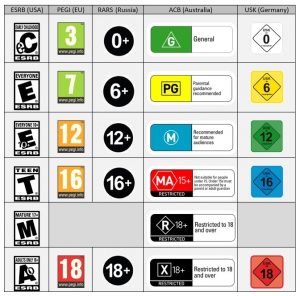This is the final paper presented by a recent graduate of the Global Digital Marketing and Localization Certification (GDMLC) program. This paper presents the work being produced by students of The Localization Institute’s Global Digital Marketing and Localization Certificate program. The contents of this Paper are presented to create discussion in the global marketing industry on this topic; the contents of this paper are not to be considered an adopted standard of any kind. This does not represent the official position of Brand2Global Conference, The Localization Institute, or the author’s organization.
Abstract
Game localization now plays a big part in the industry’s total revenue stream. Yet, the process of altering game elements to appeal to a global market is sometimes qualified of ‘censorship’ by some vocal strong groups of fans (core gamers) who can now spot the difference from the source language via the instant access to international digital media. Core gamers feel their expectations are being denied for business reasons and their critics can cause a possible impact on sales or brand image. This paper discusses first the common cultural issues encountered in game localization, followed by a selection of cases that triggered players’ uproar. Finally, this paper explores several ways to find the right balance between the different levels of expectations and how to anticipate them.
Introduction
Localization is defined by Singh (2011: 124) as “the process of adapting products and services (websites, manuals and software applications) to the linguistic, cultural, technical, functional, and other locale-specific requirements of the target market”. For video games, there is a general practice Mangiron (2006) describes as making sure the players can experience and enjoy the game as if it were initially created in their own language. Many aspects need to be taken into account to provide this illusion, such as providing different box packagings or altering game elements that were not present in the original product but gives a local feel to the players. Japanese names for instance may be changed into Western names. 
Edwards (2012) defines two types of audiences: the intended (regular game players and/or familiar with the context) and the unintended (little familiarity or no exposure to games). She recommends companies to create content that are compatible with the expectations of those two groups to appeal them. One of those expectations is to anticipate the cultural sensitivity that may offend consumers from different locales, such as: politics, history, faith, mentality, behavior, geography, status, lifestyle, or recent world events. Recently for instance, the publisher Electronic Arts apologized for an oversight in their game EA Sports UFC 2 (2016) in which it gave the non-fictional practicing Muslim fighter Khabib Nurmagomedov a Christian victory celebration gesture, which disappointed Muslim players and the fighter himself.
Yet cultural content that may be removed in certain locales to attract a wider audience and maximize the ROI can also trigger core gamers’ uproar and some of them accuse companies of censorship as the game delivered may not be seen as complete and therefore not faithful to the original product.
Cultural gap between Japanese games connoisseurs and the general public 
The latest example is Nintendo’s title Fire Emblem Fates (2016) which sparked a great controversy as several removals were made for its US release, such as a minigame where the player can rub allies’ faces in his/her private quarters to strengthen relationships. Another cut-off is a storyline where a character drugs a homosexual female character and convinces her to change her sexual orientation. There were also several lines of dialogues where two characters discuss about their shared love for pickles that got erased and replaced by ellipses.
In this day and age of the internet, masses of fans can now rally globally to express their concerns over the localization process in social media and address directly their feelings to the publishers involved. To some core gamers, Consalvo remarks they perceive games as an artistic form and no textual or visual elements should be altered to preserve the intent of the author (2015: p.143). They often believe that those changes are made solely for business reasons or generating more money. In the present case they used the Twitter hashtag #Torrentialdownpour to complain about the decision-making process and created several online petitions to stop further removals in future games. Orselli, the editor-in-chief of Niche Gamer claims: “I’m of the volition that we should celebrate other cultures and let media from such cultures exist as is, and not have it be altered or sugar-coated for foreign audiences. It’s a catch-22 when trying to appeal for people who may not appreciate things alien to their culture goes and alienates the people who enjoy experiencing other cultures.” (Kotaku, 2015).
Those conflicts can be regular, as Jenkins highlights “fan and corporate interests are never perfectly aligned” (2008, para 15). It seems natural Nintendo wanted to avoid negative media attention by erasing what may be perceived as a “gay conversion therapy” or implicit sexual connotations. Regarding certain dialogues, Nintendo might have assessed they would not be as funny for a Western audience.
As said earlier, game localization generally requires erasing any foreign cultural element to make sure players would experience the same enjoyment as the original audience. This practice is inevitable in terms of money and immersion as Bernal-Merino (2007) explains:
“[What we must] take into account is the cultural context the game is taking for granted. We can assume that hardcore gamers around the globe share a small degree of background knowledge, but that doesn’t apply to most players. The place we grow up in, the customs and lifestyle of the country we live in, can be dramatically different from one player to another. Concepts like ‘funny,’ ‘acceptable,’ ‘honorable’ and so forth – the very way people interact – depend on long established traditions particular to each country or territory. […] Apart from the obvious legal implications, these issues can influence greatly the number of sales in a particular country.”
On the contrary, Consalvo thinks the popularity of those games are precisely due to the foreign cultural elements present: “while most companies attempt through localization to erase the ‘cultural odor’ of their products, more recent hardcore Western fans seem intent on preserving as much of the local Japanese ‘flavor’ as possible. Thus leaving some of the ‘Japanese-ness’ in the game might be as much of a draw as the game’s skillful use of language.” (2015: 129). O’Hagan (2013: 174) also precises games which have plenty of foreign cultural elements can also be popular internationally as long as the narrative and gameplay are entertaining.
To appease core gamers, Orselli states: “I think if more publishers would at least talk about the changes they make and why they made them. People would be a LOT more understanding, at the very least. Instead we mostly get quiet edits/changes/removal of content, and most people avoid talking about it.” (Kotaku, 2015)
Some severe reactions may be due to a lack of knowledge of the industry: players may not be aware of standards and regulations regarding the age-rating system specific to every region that might forbid a release or restrict the audience. O’Hagan and Mangiron (2013: 207) specify Japanese regulations are not as strict regarding contents related to nudity, alcohol or sexuality, which means they would generally be banned for the underage audience internationally when those elements are not toned down.
Localization is also a big investment and the industry is tied to tight deadlines that may not give enough time or funds to provide creative translations. Besides, translating Japanese characters is a challenge: the author Kiyama (1999: 18) says ‘Puns and regional dialects are the bane of all translators of Japanese. […] they revolve around words that sound the same yet have different meanings. These are usually impossible to translate, especially when linked with a visual element.’
Additionally, translations might not be as accurate as the source language because of space restrictions: Latin alphabet appears bigger on screen compared to Japanese characters in text boxes, which would lead to higher development costs to adjust the layout.
Finding the right balance
This paper showed how game localization can create conflicts with some consumers who feel their expectations are not met when adapting a foreign game. It is difficult to accommodate core gamers who view games as an art and the general public who may not be familiar with a particular foreign culture.
Backlash can be anticipated if game developers engage early with localization experts so that they can identify potentially sensitive regional content that game developers may not be aware of. Furthermore, this would also limit literal or uncreative translations that can negatively affect the gaming experience as it might pull the player out of immersion.
Obviously it does not sound ideal if the player needs to search for a particular cultural term frequently during their game experience. However this may also initiate a learning process for different cultures. Perhaps an option could be for game developers to add a feature that would allow people to have an instant access to the definitions for foreign terms. This way, players who do not wish to constantly research for definitions could still see what it is and other players could have it turned off and not break the immersion. Another way to explore would be to have the possibility to implement alternative textual content that would display foreign cultural names.
This would involve more investment; however this could be a further step in game localization and globalization as a whole. Moreover this would improve the brand image of game companies, without turning off any audience. Instead of erasing elements deemed as “alien”, keeping them may break down cultural barriers over time.
References
Bernal-Merino, M. (2007). Localization and the Cultural Concept of Play. Available at: http://www.gamecareerguide.com/features/454/localization_and_the_cultural_.php
Consalvo, M. (2015). Atari to Zelda. Cambridge, MA: MIT Press.
Critchley, M. (2016). EA Sports apologise for Muslim UFC fighter’s ‘sign of the cross’ celebration. [online] The Independent. Available at: http://www.independent.co.uk/sport/general/mma/ea-sports-issue-apology-to-khabib-nurmagomedov-over-sign-of-the-cross-gesture-in-ufc-video-game-a6948391.html
Edwards, K. (2012). The Top 5 Cultural Issues in Games. Available at: http://www.youtube.com/watch?v=FeORLimDppM
Jenkins, H. (2008). The Moral Economy of Web 2.0 (Part Three). [online] Henryjenkins.org. Available at: http://henryjenkins.org/2008/03/the_moral_economy_of_web_20_pa_2.html
Kiyama, H. and Schodt, F. (1999). The four immigrants manga. Berkeley, Calif.: Stone Bridge Press.
Klepek, P. (2015). From Japan, With Changes: The Endless Debate Over Video Game ‘Censorship’ [online] Kotaku.com. Available at: http://kotaku.com/from-japan-with-changes-the-endless-debate-over-video-1747960323
Klepek, P. (2016). The Fight Over The Best Way to Translate Fire Emblem Fates. [online] Kotaku.com. Available at: http://kotaku.com/the-fight-over-the-best-way-to-translate-fire-emblem-fa-1761106038
Mangiron, C. and M. O’Hagan. (2006). Game Localisation: Unleashing Imagination with ‘Restricted’ Translation. The Journal of Specialised Translation 6: 10-21. www.jostrans.org/issue06/art_ohagan.php
Mangiron, C. and M. O’Hagan. (2013). Game Localization: Translating for the global digital entertainment industry. Amsterdam and Philadelphia. PA: John Benjamins.
Singh, N. (2012). Localization strategies for global e-business. Cambridge: Cambridge University Press.
Copyright © 2016 The Localization Institute. All rights reserved. This document and translations of it may be copied and furnished to others, and derivative works that comment on or otherwise explain it or assist in its implementation may be prepared, copied, published, and distributed, in whole or in part, without restriction of any kind, provided that the above copyright notice and this section are included on all such copies and derivative works. However, this document itself may not be modified in any way, including by removing the copyright notice or references to The Localization Institute, without the permission of the copyright owners. This document and the information contained herein is provided on an “AS IS” basis and THE LOCALIZATION INSTITIUTE DISCLAIMS ALL WARRANTIES, EXPRESS OR IMPLIED, INCLUDING BUT NOT LIMITED TO ANY WARRANTY THAT THE USE OF THE INFORMATION HEREIN WILL NOT INFRINGE ANY OWNERSHIP RIGHTS OR ANY IMPLIED WARRANTIES OF MERCHANTABILITY OR FITNESS FOR A PARTICULAR PURPOSE.
Author Bio:
This student is a localization professional with over five years of experience in different renowned video game companies. All views are his/her own and not of any of employers.
Note to readers – We have chosen to keep the identity as “anonymous” only due to the highly polarized climate in the gaming localization world. While this student’s paper is a small commentary, many other’s in the industry have been targeted for expressing their own views on localizing games.











